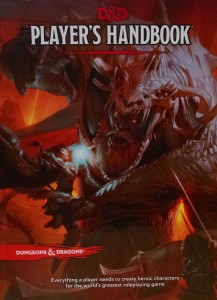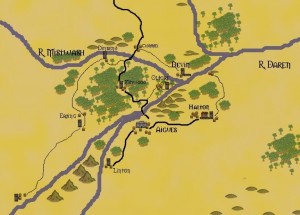Banquet of Horrors
 In sumptuous banquet hall in the Tower of Zards, the walls are festooned with skeletons in manacles. On a table laid with golden plates, cups, and cutlery, there lay beautiful bejeweled forks bearing a curse. Upon picking a fork up characters are compelled to begin eating themselves. Every round affected characters must succeed on a DC 13 Charisma or Strength saving throw or stab themselves with the ornate fork and eat their own flesh, dealing 1 HP of damage.
In sumptuous banquet hall in the Tower of Zards, the walls are festooned with skeletons in manacles. On a table laid with golden plates, cups, and cutlery, there lay beautiful bejeweled forks bearing a curse. Upon picking a fork up characters are compelled to begin eating themselves. Every round affected characters must succeed on a DC 13 Charisma or Strength saving throw or stab themselves with the ornate fork and eat their own flesh, dealing 1 HP of damage.
The skeletons in manacles will begin a mocking, cruel cackling if anyone picks up a fork and takes a bite of themselves.
If they are incautious, multiple player characters may end up feasting on themselves. The curse can be temporarily interrupted by intoning a solemn prayer to the gods, or through use of a cleric’s turning power. The curse can only be ended permanently by a remove curse spell, or by melting the cutlery down, destroying most of their value. Until such time, any time the cursed PCs eat something, the curse activates again, they find the evil fork inexplicably in their hand, and they must make a Charisma or Strength save every round as described above. This may lead to fatigue or inability to rest if the players don’t eat so as to avoid the curse.
Posted in 5th edition Dungeons & Dragons, Encounter, Magic Item, Trap and tagged cursed, Tower of Zards by Adam A. Thompson with no comments yet.
Dungeons & Dragons 5th Edition – First Impressions
Welcome – I am proud to announce that this review of the 5th edition Dungeons & Dragons Player’s Handbook is the 750th post on Claw / Claw / Bite!
In addition this is the inaugural post on the new blog and website. The server hosting this blog went down a few months ago. Due to incomplete backups we have had to rebuild a several years of the blog one post at a time. This has only been possible due to the Internet Archive‘s captures of the original blog. Thank you, Internet Archive, you were my only hope. With the help of those captures the many years of our creative works are once again available to the public.
To introduce myself – I’ve been playing Dungeons & Dragons since 1982 or so, and I’ve been publishing material for role-playing games through Unicorn Rampant since 2006. You can see the fruits of our labors here. Feel free to leave comments here on the blog, and expect this new site to continue to evolve and change as we clean up from the move and reconstruction.
I’ve been reading the 5th Edition Dungeons & Dragons Player’s Handbook from cover to cover in preparation for playing and writing material for the new rules. As someone who has already played more than 5 different versions of this game, along with many other role-playing games, I’m very interested in how well this new edition of gaming books are written, and how fun the game looks to play.
My summary? The new edition of the Player’s Handbook is well done, both for new players and those of use who have been loving this hobby for a long time. A few of the best ideas from 4th edition have been baked into a streamlined, inspiring, familiar-feeling new edition of Dungeons & Dragons. Clear, evocative writing illuminates character options and rules throughout, with a healthy dose of illustrative art, and fun tables and charts.
Reviewing the table of contents, I’m glad to report that they have more or less kept the same order of chapters that has been in use since the AD&D Player’s Handbook. The 5e D&D PHB has that same sensible old order of topics that make it a quick and easy-to-use resource for a veteran player like me: Characters, Equipment, Rules, Spells, and Appendices. There is also an extensive index.
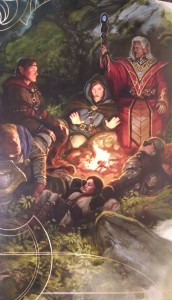 The Player’s Handbook is graced throughout with a generous amount of varied art. Realistic-looking pieces gaze across the page at more illustrative ones, and everything is vividly colorful and well executed.
The Player’s Handbook is graced throughout with a generous amount of varied art. Realistic-looking pieces gaze across the page at more illustrative ones, and everything is vividly colorful and well executed.
The introduction lends good context to what this strange game is, with evocative cues for the imagination throughout. For new players this section of a role-playing game rule book is hugely important – not just to summarize how the game is played but to give the reader an idea as to why it is played. If a prospective player reads the fist page and it doesn’t make sense, or if it just falls flat, then that reader might miss out on this incredible game.
The worlds of Dungeons & Dragons are presented as individual creations with similarities, and the official settings of Greyhawk, The Forgotten Realms, and Dragonlance are used for examples throughout. Thus the reader is presented with a rich variety of inspirational details while being encouraged to create their own unique game.
The character creation section does a good job of walking the player step-by-step through the process of filling out the character sheet. The basics of what makes up a character and relevant rules are explained as needed along the way. I applaud the tutorial-style approach to the overview.
The races presented are divided into common and uncommon races, the former being the humans, halflings, elves and dwarves we’re familiar with from Tolkien’s Middle Earth. Personally, I find it jives nicely with my mental image of a fantasy world, wherein the included dragonborn, gnomes, half-elves, half-orcs and tieflings are presented as being less prevalent. Of course an individual Dungeon Master could write whatever mix of races they wanted into their own campaign, changing things to suit their group’s tastes, but that goes for everything in these books. There are a wealth of explanatory sidebars filled with in-game role-playing details about how the various races relate to each other in this typical fantasy world. In an example of how this edition has streamlined the rules Darkvision has been simplified – they combined what previous editions have called low-light vision and darkvision and gave it to everyone except humans, halflings, and dragonborn.
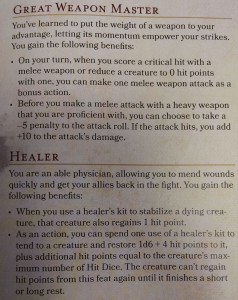 The classes received a similar treatment – there are lots of well-written inspirational passages that give a variety of ideas about what each different class can be. Class abilities have been both expanded and streamlined. For example there are now five different fighting styles, and rangers, fighters, and paladins get to chose from different subsets of the five. For the magically inclined classes spellcasting has also been simplified and made more flexible while retaining the core feel for each class. Also, some of the most popular prestige classes have been written into the core classes as options that can be chosen as the character progresses to higher levels. The cherry on top is the inclusion of the warlock class as one of the core classes. Recognizable feats have been combined and made more fun – the cleave and power attack feat takes effect on rolls of natural 20, for example. Other rules have similar dramatic effects when a 1 or a 20 is rolled.
The classes received a similar treatment – there are lots of well-written inspirational passages that give a variety of ideas about what each different class can be. Class abilities have been both expanded and streamlined. For example there are now five different fighting styles, and rangers, fighters, and paladins get to chose from different subsets of the five. For the magically inclined classes spellcasting has also been simplified and made more flexible while retaining the core feel for each class. Also, some of the most popular prestige classes have been written into the core classes as options that can be chosen as the character progresses to higher levels. The cherry on top is the inclusion of the warlock class as one of the core classes. Recognizable feats have been combined and made more fun – the cleave and power attack feat takes effect on rolls of natural 20, for example. Other rules have similar dramatic effects when a 1 or a 20 is rolled.
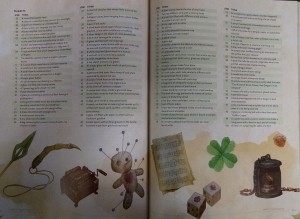 Throughout the book there are great tables and charts. Finding the trinkets chart, for example, just thrilled me. What a great resource to inspire players and DMs! And there are nods there, as well as through the rest of the book, to great classic D&D adventures and supplements I’ve played with such as The Temple of Elemental Evil. When looking for inspiration, trying to create your first dungeon, or just rolling random encounters and treasure, a evocative table to roll or pick from is a great tool. I’m glad they included lots of them.
Throughout the book there are great tables and charts. Finding the trinkets chart, for example, just thrilled me. What a great resource to inspire players and DMs! And there are nods there, as well as through the rest of the book, to great classic D&D adventures and supplements I’ve played with such as The Temple of Elemental Evil. When looking for inspiration, trying to create your first dungeon, or just rolling random encounters and treasure, a evocative table to roll or pick from is a great tool. I’m glad they included lots of them.
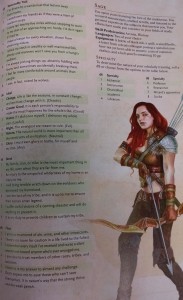 The excellent writing continues in the character details chapter, which covers description, values, bonds, flaws, alignment, backgrounds, feats, and inspiration. The backgrounds feature is a great innovation – players pick one of the many backgrounds, such as folk hero, noble, or acolyte, and that background confers skill and tool proficiency along with other character features. Each background has plenty of example prompts to inspire some creative storytelling for your character. It’s a huge improvement, in terms of player experience, over the skill point system which was always one of the most tedious parts of character creation in my opinion. Now players can just pick one background that confers a group of related skills and be done with it. Since your choice is not tied to your class players get to have a bit more variety in their characters. For those who prefer to craft something individual and different there are rules for that as well.
The excellent writing continues in the character details chapter, which covers description, values, bonds, flaws, alignment, backgrounds, feats, and inspiration. The backgrounds feature is a great innovation – players pick one of the many backgrounds, such as folk hero, noble, or acolyte, and that background confers skill and tool proficiency along with other character features. Each background has plenty of example prompts to inspire some creative storytelling for your character. It’s a huge improvement, in terms of player experience, over the skill point system which was always one of the most tedious parts of character creation in my opinion. Now players can just pick one background that confers a group of related skills and be done with it. Since your choice is not tied to your class players get to have a bit more variety in their characters. For those who prefer to craft something individual and different there are rules for that as well.
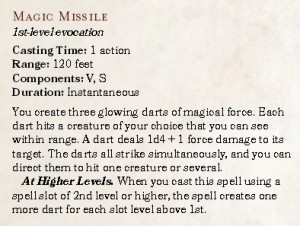 The magic section includes all the expected spells, and some new ones from 4th edition. The spells are simple and clear, most a few short paragraphs long, and the mechanics for increasing the power of lower-level spells are great. Using a higher level spell slot boosts the power of most spells in a nice, linear way. Spellcasting classes have 0th level cantrips they can cast an unlimited number of times, but because the hit point and damage totals are lower than they were in 4th edition, players shouldn’t have to actually cast them an unlimited number of times any more (sorry, 4th edition. That’ll be the only joke I make about you). Even spells that have been tricky or confusing to some in previous editions , such as Dispel Magic, have been streamlined and given more flexibility. Spells are one of the most important aspects of Dungeons & Dragons and the authors have done a great job with them.
The magic section includes all the expected spells, and some new ones from 4th edition. The spells are simple and clear, most a few short paragraphs long, and the mechanics for increasing the power of lower-level spells are great. Using a higher level spell slot boosts the power of most spells in a nice, linear way. Spellcasting classes have 0th level cantrips they can cast an unlimited number of times, but because the hit point and damage totals are lower than they were in 4th edition, players shouldn’t have to actually cast them an unlimited number of times any more (sorry, 4th edition. That’ll be the only joke I make about you). Even spells that have been tricky or confusing to some in previous editions , such as Dispel Magic, have been streamlined and given more flexibility. Spells are one of the most important aspects of Dungeons & Dragons and the authors have done a great job with them.
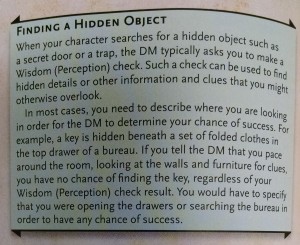 In an admirable move, Wizards of the Coast has released the basic rules for free as a PDF. It includes rules for playing a human, dwarf, elf or halfling and cleric, fighter, rogue and wizard, and about as many spells as were in the AD&D PHB. http://dnd.wizards.com/articles/features/basicrules?x=dnd/basicrules
In an admirable move, Wizards of the Coast has released the basic rules for free as a PDF. It includes rules for playing a human, dwarf, elf or halfling and cleric, fighter, rogue and wizard, and about as many spells as were in the AD&D PHB. http://dnd.wizards.com/articles/features/basicrules?x=dnd/basicrules
In conclusion I will say that I’m really looking forward to giving this new set of rules a spin. The writers at Wizards of the Coast have produced a new edition of the game that looks to have gotten the rules out of the way so that we can focus on the exciting stories we’re trying to tell. Keep watching this spot on Claw / Claw / Bite for more impressions as we play.
Posted in 5th edition Dungeons & Dragons, Editorial, Review and tagged Fantasy by Adam A. Thompson with 2 comments.
The Sword of Storms
This gleaming blue-steel blade is tied to the power of the storms, and in addition to it’s +2 enhancement bonus, deals an extra 1d6 points of lightning damage on a hit. Those who wield it resist 5 points of lightning damage from any source. Additionally, the weapon can strike with the power of a thunderclap – once per day, upon a successful blow, the wielder can force an opponent to succeed on a DC 15 Constitution, Fortitude, or Petrify/Polymorph saving throw, or be pushed back 10 feet and stunned for one round.
Posted in 1st edition D&D, 3rd edition Dungeons & Dragons / d20 fantasy / Pathfinder, 5th edition Dungeons & Dragons, Equipment, Magic Item and tagged sword by Adam A. Thompson with no comments yet.
Serious Injuries, Scars and Maimings
Axes grind and maces clash as wounded fighters fall to the ground
Severd limbs and fatal woundings, bloody corpses lay all around
Iron Maiden
“Invaders”
Want to up the ante in your game? Characters get knocked down just to get back up again? Try these optional rules for character scars and maimings.
Whether blasted in the heart with a ray of white-hot flame, shot in the liver with an arrow, or stabbed in the neck by a raving marauder, some wounds are going to leave a mark, if not result in serious and permanent disability, assuming that the victim survives at all. The maimed, the amputees, the crippled begging outside the temple of Heironious, Aries, or Hextor. All are the evidence of the price of the battlefield. Accordingly, these rules are intended to bring more life to the threats which wound the crusaders.
Optional Rule: Serious Injuries, Scars and Maimings
When a hero or important NPC takes enough damage to be reduced to negative hit points, check on the Serious Injury, Scars and Maimings chart to determine where the blow that laid the character low fell.
With the exception of destroyed organs and severed limbs, which require regeneration to regain, these effects should be reversible through the use of magic such as Restoration, Heal, or other magic or effects that heal permanent ability damage. There are also rumors of magicians and priests who have crafted magical arms and legs for those so hurt, as well.
Serious Injuries, Scars and Maimings (roll 1d20)
| Roll | Effect location | Full description of effects |
| 1-4 | Leg | -2 strength, -2 dexterity, and lose use of wounded limb: roll 1d20, on 1-11 limb is crippled and character moves at half speed, 12-20 limb is severed and character moves at 1/2 speed with a crutch but otherwise must crawl at 1/4 speed. |
| 5-6 | Guts | -4 constitution, sensitive stomach: must eat special diet or additional -1 constitution per day. |
| 5-6 | Groin | -2 strength, -2 constitution, cannot reproduce. |
| 9-12 | Chest | -2 constitution, -2 strength, after jogging or running, make a DC 10 saving throw or be dazed for 1 round. |
| 13-16 | Arm | -2 strength, -2 dexterity, and lose use of wounded limb: roll 1d20, on 1-11 limb is crippled, 12-20 severed. |
| 17-20 | Head | Roll once on Head Chart, below. |
Head Chart (roll 1d20)
| Roll | Effect location | Full description of effects |
| 1-4 | Eye | -2 on perception or spot checks, -2 on all ranged attacks. Second lost eye blinds character. |
| 5-8 | Ear | -2 on perception or listen checks. Second lost ear deafens character. |
| 9-12 | Face | -2 charisma due to serious scarring or deformation of face. |
| 13-16 | Mouth | -2 on all charisma based skills, due to difficulty understanding speech from character. |
| 17-20 | Throat | The character is unable to speak. |
As always, when introducing optional rules like this, especially rules that increase the danger for the player characters, talk it over with the group you’re playing with. Unless everyone consents to having more fun by making the game more dangerous, don’t use them. Nothing makes some players hate playing more than DMs springing new rules on them out of the blue.
These optional rules are compatible with 3.5 D&D, 4e D&D, d20 modern, and Pathfinder RPG systems.
Posted in 1st edition D&D, 3rd edition Dungeons & Dragons / d20 fantasy / Pathfinder, 4th edition Dungeons & Dragons, 5th edition Dungeons & Dragons, Variant Rules by Adam A. Thompson with no comments yet.
A Fast and Simple Critical Fumble Option
I like critical fumbles in my games for a number of reasons. First of all, as a storyteller I like it when disaster strikes. When I’m visualizing and describing a pitched battle I relish the possibility that one of the combatants might slip in the growing pool of blood on the flagstones or over-swing their battle-axe and accidentally strike one of their comrades. It makes the battles feel more real to me, and it also makes combat feel more dangerous.
In practical terms, it does make combat more dangerous for everyone involved. If big monsters might accidentally kill their minions when they’re trying to smash that knight, or if the players might lose their footing and fall prone, then there’s more damage being handed out every round. It makes the monsters go down a little more quickly, but it also exposes the players to more danger. As DM I consider this a win-win because I like my games to feel as dangerous as possible, and I like combat to go quickly.
But I don’t like to slow my games down with looking anything up. I’ve been playing and running games long enough that I know pretty much all the rules by heart, and for my fumble rules I wanted to come up with something that could easily be memorized and that wouldn’t slow down combat with referencing a table. Therefore, I came up with the following optional rule.
Critical Fumbles
Any time an attacker rolls a 1 on their attack roll die, they fumble. Roll another d20 to determine the severity of the fumble.
Die Roll Fumble Result
16-20 Character is off-balance and grants combat advantage until the end of the current character’s next turn.
11-15 Attacker looses their footing and falls prone.
6-10 Attacker drops their weapon or loses their next attack if weaponless.
1-5 Attacker targets an ally or themselves with the fumbled attack. Re-roll the attack to see if it hits the new target.
I like it because it’s nice and simple – there are four results with increasingly dire consequences, so it’s easy for me to remember “off balance, fall prone, drop weapon, or attack self or ally”.
Let us know what you think in the comments below, or on our Facebook page.
Posted in 1st edition D&D, 3rd edition Dungeons & Dragons / d20 fantasy / Pathfinder, 4th edition Dungeons & Dragons, 5th edition Dungeons & Dragons, Variant Rules and tagged critical fumble by Adam A. Thompson with no comments yet.
Traveling to Minwood
After the battle of Clommel Bridge the players and their liege, Ludwig Staledwo, take their army in pursuit of Count Aguies and his protege, Trent. The most direct route is the road through Minwood. Once there they must decide how to deal with the hostile lord of Minwood, and possibally Oltorf as well.
- Treatment of prisoners – if the players captured any Knights in the previous encounters (such as Ilúvënis, the haughty Eledrin Lord of Linton, and Jack the young human son of Lord Erding) they must decide how they are to be treated.
As you survey the battlefield that Aguies has just fled, one of your troops approaches, looking uncertainly back at Iluvenis and Jack, the knights who have surrendered to you. “What should I do with these two, m’lord?”
If given general liberty, good food and wine and otherwise treated as guests they will be social with the players, riding and talking with them, and may be disposed to ally with the party’s liege Ludwig later. If kept harshly they may try to escape or stir up trouble – Iluvens can teleport, so keeping him prisoner will be hard. If killed their families will greatly resent Ludwig during the reconciliation later.
Skill Challenge Level 5, complexity 1, XP 200, 3 successes before 3 failures –
Primary Skills (DC 12); Diplomacy, Intimidate to make friends or control the prisoners, can be carried out over the course of the journey to Castle Aguies.
Success – the players make a good impression on their prisoners or frighten them into submission.
Failure – the prisoners may attempt to convince some of the player’s troops to join them or they may try to escape (use Knight of the Realm stats for Jack, and Eladrin Knight stats (see Monster Manual) for Iluvens. - During the journey to Castle Aguies, the players may have a minor encounter if they want to attack the lightly defended Oltorf and Minwood – who may just surrender with a skill challenge. Lord Jared of Oltorf is still with Count Aguies, but Lord Toel of Minwood was injured at the battle at the bridge and is recuperating in his keep with his family and a small contingent of guards.
The trip to Minwood takes 2-3 days for the player’s army.
Description – they party comes upon the town, and it seems deserted – the keep is closed up and archers watch from their positions on the battlements / arrow slits. If parleyed with, they say that Duke Aguies rode by and warned them that Ludwig’s army was coming. They will gladly say that they will not attack the army’s flank in an attempt to convince the players to continue on (Insight or History DC 14 to realize that this is probably not ture).
Skill Challenge – Level 7, complexity 4 – xp 1200. 10 successes before 3 failures. Primary skills – (DC 14) Intimidate checks to bully them into surrendering, Bluff checks to trick them into giving up, Diplomacy checks to convince them they will not be hurt if they surrender, History to make the argument that Ludwig is the rightful lord of these lands, Stealth checks to sneak into the castle, Athletics checks to scale the walls.
Secondary skills – (DC 19) Endurance checks to keep watch while blockading them, keeping supplies from getting in or out, Nature to notice the spring feeding water to the keep, and to block or taint it, Stealth and then Acrobatics to squeeze in through the grate that lets the spring water in.
Success – The castle’s defenders surrender to Ludwig’s army and if they succeeded at at least one Diplomacy check, the Lord swears fealty to Ludwig. Otherwise they merely surrender and the party faces a dilemma – what do they do with the captured troops? The sword of war suggests conscription or execution.
Failure – The defenders refuse to surrender: to take the castle they must defeat the well-fortified 20 troops defending the place (see encounter below). If they do not take Minwood and Oltorf there is a counter attack from these troops during the siege of Aguies detailed below.
Development – given the opportunity, the Sword of War will make it’s bearer attack the keep.Encounter – Level 7 – XP 1400 –
If the players do not convince the defenders to surrender, they must defeat the well-fortified troops defending the keep. While the player’s troops help fight the rest of the forces off-screen (or are repelled by archers if sent in alone), the players make the main assault on the keep and fight:
Creatures
- Knight – xp 250
- pikeman – xp 250
- 3 x human guards (see MM) – xp 150 ea
- 6 x human lackeys (see MM) – xp 75 ea
Treasure – small money parcel as the keep and town are looted. Simple skill challenge to keep the looting from turning into pandemonium as their troops grab everything not bolted down, including livestock, furniture, erc. – the Sword of War tries to encourage the looting. Failure – flush with their loot, four of the player’s troops desert in the night.
Development – If they do not take Minwood and Oltorf there is a counter attack from these troops during the siege of Aguies (to be detailed later).
Posted in 5th edition Dungeons & Dragons, Encounter and tagged Campaign: Heir of Soguer, encounter: skill challenge level 5, encounter: skill challenge level 7 by Adam A. Thompson with no comments yet.
